媒介术语&媒介行业术语
- 格式:doc
- 大小:115.00 KB
- 文档页数:18

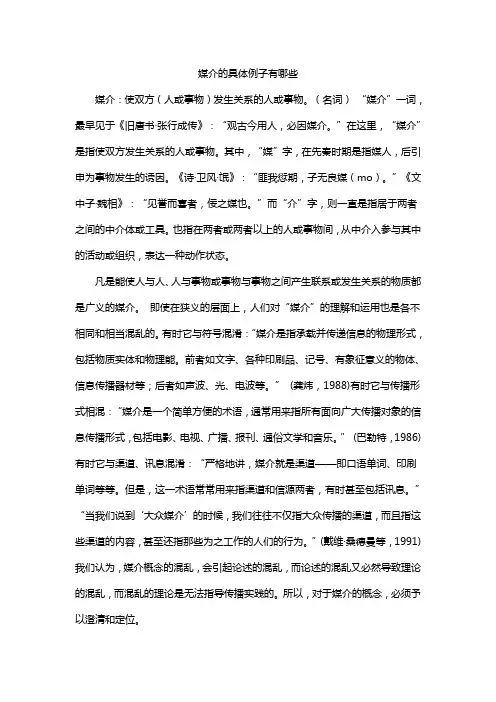
媒介的具体例子有哪些媒介:使双方(人或事物)发生关系的人或事物。
(名词)“媒介”一词,最早见于《旧唐书·张行成传》:“观古今用人,必因媒介。
”在这里,“媒介”是指使双方发生关系的人或事物。
其中,“媒”字,在先秦时期是指媒人,后引申为事物发生的诱因。
《诗·卫风·氓》:“匪我愆期,子无良媒(mo)。
”《文中子·魏相》:“见誉而喜者,佞之媒也。
”而“介”字,则一直是指居于两者之间的中介体或工具。
也指在两者或两者以上的人或事物间,从中介入参与其中的活动或组织,表达一种动作状态。
凡是能使人与人、人与事物或事物与事物之间产生联系或发生关系的物质都是广义的媒介。
即使在狭义的层面上,人们对“媒介”的理解和运用也是各不相同和相当混乱的。
有时它与符号混淆:“媒介是指承载并传递信息的物理形式,包括物质实体和物理能。
前者如文字、各种印刷品、记号、有象征意义的物体、信息传播器材等;后者如声波、光、电波等。
”(龚炜,1988)有时它与传播形式相混:“媒介是一个简单方便的术语,通常用来指所有面向广大传播对象的信息传播形式,包括电影、电视、广播、报刊、通俗文学和音乐。
”(巴勒特,1986)有时它与渠道、讯息混淆:“严格地讲,媒介就是渠道——即口语单词、印刷单词等等。
但是,这一术语常常用来指渠道和信源两者,有时甚至包括讯息。
”“当我们说到‘大众媒介’的时候,我们往往不仅指大众传播的渠道,而且指这些渠道的内容,甚至还指那些为之工作的人们的行为。
”(戴维·桑德曼等,1991)我们认为,媒介概念的混乱,会引起论述的混乱,而论述的混乱又必然导致理论的混乱,而混乱的理论是无法指导传播实践的。
所以,对于媒介的概念,必须予以澄清和定位。
吴东权在《中国传播媒介发源史》(1988)一书中认为,将“media”,翻译成“媒介”不太稳妥,不如译成“媒体”。
因为“体”字本身含有身体、本体、形质、形状的意思。
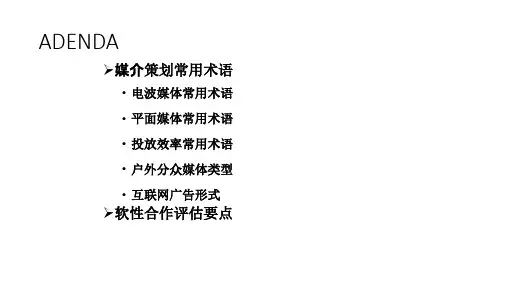
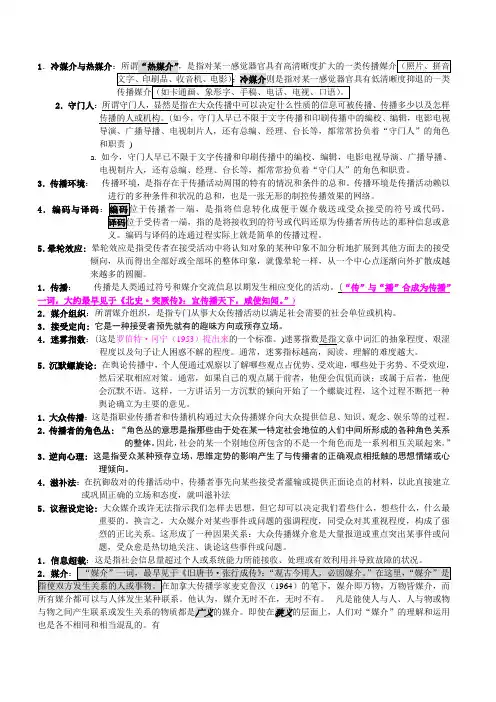
1.冷媒介与热媒介2.守门人:所谓守门人,显然是指在大众传播中可以决定什么性质的信息可被传播、传播多少以及怎样传播的人或机构。
(如今,守门人早已不限于文字传播和印刷传播中的编校、编辑,电影电视导演、广播导播、电视制片人,还有总编、经理、台长等,都常常扮负着“守门人”的角色和职责)a. 如今,守门人早已不限于文字传播和印刷传播中的编校、编辑,电影电视导演、广播导播、电视制片人,还有总编、经理、台长等,都常常扮负着“守门人”的角色和职责。
3.传播环境:传播环境,是指存在于传播活动周围的特有的情况和条件的总和。
传播环境是传播活动赖以进行的多种条件和状况的总和,也是一张无形的制控传播效果的网络。
4.编码与译码义。
编码与译码的连通过程实际上就是简单的传播过程。
5.晕轮效应:晕轮效应是指受传者在接受活动中将认知对象的某种印象不加分析地扩展到其他方面去的接受倾向,从而得出全部好或全部坏的整体印象,就像晕轮一样,从一个中心点逐渐向外扩散成越来越多的圆圈。
1.传播:传播是人类通过符号和媒介交流信息以期发生相应变化的活动。
(“传”与“播”合成为传播”一词,大约最早见于《北史·突厥传》:宜传播天下,咸使知闻。
”)2.媒介组织:所谓媒介组织,是指专门从事大众传播活动以满足社会需要的社会单位或机构。
3.接受定向:它是一种接受者预先就有的趣味方向或预存立场。
4.迷雾指数:(这是罗伯特·冈宁(1953)提出来的一个标准。
)迷雾指数是指文章中词汇的抽象程度、艰涩程度以及句子让人困惑不解的程度。
通常,迷雾指标越高,阅读、理解的难度越大。
5.沉默螺旋论:在舆论传播中,个人便通过观察以了解哪些观点占优势、受欢迎,哪些处于劣势、不受欢迎,然后采取相应对策。
通常,如果自己的观点属于前者,他便会侃侃而谈;或属于后者,他便会沉默不语。
这样,一方讲话另一方沉默的倾向开始了一个螺旋过程,这个过程不断把一种舆论确立为主要的意见。
![[广告]大众媒介广告术语ABC-C](https://uimg.taocdn.com/5d7d8e24de80d4d8d15a4f56.webp)
[广告]大众媒介广告术语ABC-C新华网 ( 2003-05-3010:39:31)来源:中国媒体购买直通车 cinema advertising 电影院广告 将电视广告复制为电影拷贝在影片开始前播放。
中国较大规模的影院广告始于1995年。
classified advertising 分类广告 根据不同需要分设的广告,如招聘、待聘、出租、征租、挂失、招生、征婚、讣告等。
一般用文字刊出。
color separation 分色 将彩色原稿根据加色法原理用滤色镜在负片上制成分色片。
经制版套印,按减色法原理在彩印纸上恢复原稿的色彩。
Commission 佣金 媒介给予广告代理商经办广告的劳务费。
佣金可分为明佣和暗佣。
community advertising 社区广告 以同一社区居民和公众为对象的广告,一般采用招贴、传单等形式、有社区刊物的地方,可以利用这种媒介。
competition analysis 竞争分析 直接竞争; 间接竞争; 品牌竞争的优势和劣势;当前和过去在广告主题方面以及广告和促销费用方面竞争的优势和劣势; 竞争的广告和促销进程是否为经销商所接受及其影响; 在竞争进程中有否显著的薄弱环节; 竞争费用在地理上是否分配合理; 在竞争进程中,销售队伍或生产部门有否特殊的评价。
cost per response 每一反应代价 根据广告总费用,计算出广告受众对广告所作出的每一反应(如寄券索取广告印刷品或寄回填好的折价券等)的代价。
如同时采用几种刊物作为媒体,必须在广告中以字母作为区分的符号,以便在计算反应代价时能正确统计。
这种有符号的广告称为keyed advertisement。
cost per thousand 千人成本 由某一媒介或媒介广告排期表所送达1000人所需的成本。
简称CPM。
广告主通过比较媒体的千人成本选择媒介。
计算的公式如下:千人价格=(广告费用/到达人数)×1000。
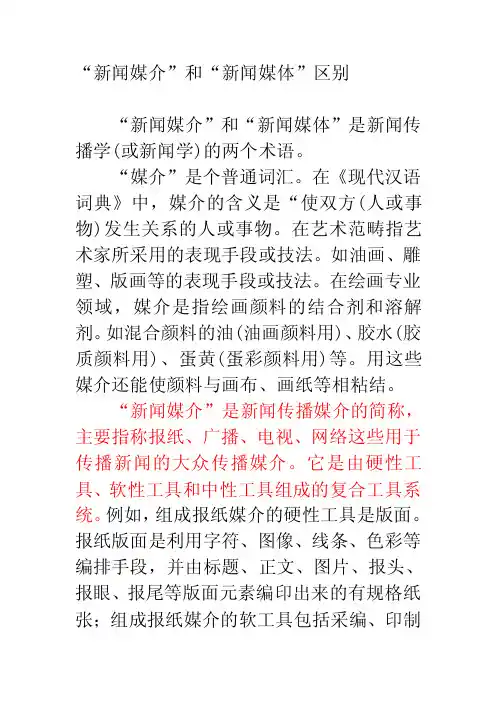
“新闻媒介”和“新闻媒体”区别“新闻媒介”和“新闻媒体”是新闻传播学(或新闻学)的两个术语。
“媒介”是个普通词汇。
在《现代汉语词典》中,媒介的含义是“使双方(人或事物)发生关系的人或事物。
在艺术范畴指艺术家所采用的表现手段或技法。
如油画、雕塑、版画等的表现手段或技法。
在绘画专业领域,媒介是指绘画颜料的结合剂和溶解剂。
如混合颜料的油(油画颜料用)、胶水(胶质颜料用)、蛋黄(蛋彩颜料用)等。
用这些媒介还能使颜料与画布、画纸等相粘结。
“新闻媒介”是新闻传播媒介的简称,主要指称报纸、广播、电视、网络这些用于传播新闻的大众传播媒介。
它是由硬性工具、软性工具和中性工具组成的复合工具系统。
例如,组成报纸媒介的硬性工具是版面。
报纸版面是利用字符、图像、线条、色彩等编排手段,并由标题、正文、图片、报头、报眼、报尾等版面元素编印出来的有规格纸张;组成报纸媒介的软工具包括采编、印制的程序、规则和方法;组成报纸媒介的中性工具就是语言文字等符号。
对于电视来说,组成电视媒介的硬性工具是指录制声像的技术设备、发射台和接收机等;软性工具包括录制声像的技术和技巧、发射和接收的程序、规则和方法;中性工具就是语言文字、图像等符号系统。
“新闻媒体”是新闻传播媒体的简称,主要指称报社、广播电台、电视台、网站、通讯社等从事新闻传播活动的组织机构。
作为社会组织实体,新闻媒体的有形构成要素是人、财、物。
其中人员是核心要素,没有人员则不能构成社会组织;其次是资金、技术设备等物质要素。
新闻媒体是被组织起来的社会群体,是为了达到某种共同的组织目标将人们的行为联合并协调起来形成的社会团体。
每个新闻媒体都有确定的组织目标,其中的每个成员也有各自的目标和任务;每个新闻媒体都有特定的组织系统、技术结构和运行机制;每个新闻媒体都要运用权力和领导行为,依靠决策和沟通来推动新闻媒体的正常运行和管理。
新闻媒体无论是内部运行,还是与社会环境系统的交流,都是有结构的整体性的组织行为。
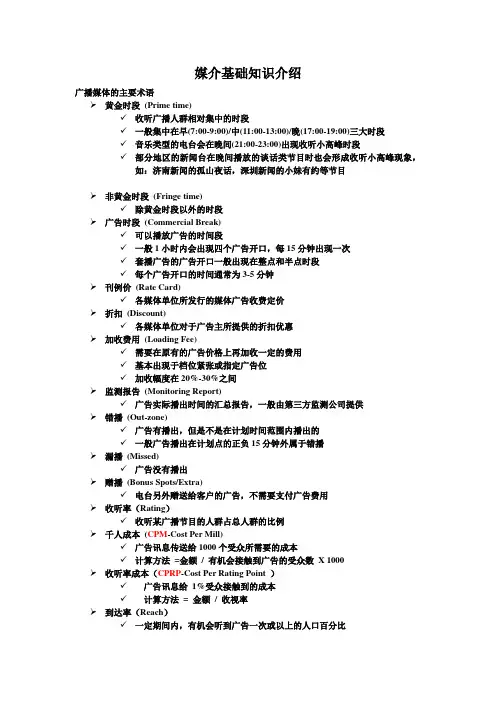
媒介基础知识介绍广播媒体的主要术语黄金时段(Prime time)✓收听广播人群相对集中的时段✓一般集中在早(7:00-9:00)/中(11:00-13:00)/晚(17:00-19:00)三大时段✓音乐类型的电台会在晚间(21:00-23:00)出现收听小高峰时段✓部分地区的新闻台在晚间播放的谈话类节目时也会形成收听小高峰现象,如:济南新闻的孤山夜话,深圳新闻的小妹有约等节目非黄金时段(Fringe time)✓除黄金时段以外的时段广告时段(Commercial Break)✓可以播放广告的时间段✓一般1小时内会出现四个广告开口,每15分钟出现一次✓套播广告的广告开口一般出现在整点和半点时段✓每个广告开口的时间通常为3-5分钟刊例价(Rate Card)✓各媒体单位所发行的媒体广告收费定价折扣(Discount)✓各媒体单位对于广告主所提供的折扣优惠加收费用(Loading Fee)✓需要在原有的广告价格上再加收一定的费用✓基本出现于档位紧张或指定广告位✓加收幅度在20%-30%之间监测报告(Monitoring Report)✓广告实际播出时间的汇总报告,一般由第三方监测公司提供 错播(Out-zone)✓广告有播出,但是不是在计划时间范围内播出的✓一般广告播出在计划点的正负15分钟外属于错播漏播(Missed)✓广告没有播出赠播(Bonus Spots/Extra)✓电台另外赠送给客户的广告,不需要支付广告费用收听率(Rating)✓收听某广播节目的人群占总人群的比例千人成本(CPM-Cost Per Mill)✓广告讯息传送给1000个受众所需要的成本✓计算方法=金额/ 有机会接触到广告的受众数X 1000收听率成本(CPRP-Cost Per Rating Point )✓广告讯息给1%受众接触到的成本✓计算方法= 金额/ 收视率到达率(Reach)✓一定期间内,有机会听到广告一次或以上的人口百分比✓不包括重叠部分✓最极限只能达100%总收听率(GRP)✓一定期间内,所有投放广告的收听率总和✓具有重叠性平均接触频次(Average Frequency)✓一定期间内,在有机会接触广告的人口中,每人接触广告的平均次数总收听率= 到达率* 平均接触频次GRP = Reach * Average Frequency广播媒体的广告形式⏹常规硬广告:15秒、20秒、30秒⏹非常规广告⏹特约、冠名报时、天气预报、正点·半点资讯、节目·栏目片头、路况播放⏹栏目合作在固定节目中穿插3-5分钟的客户信息,还可以通过电话、短消息等方式通过主持人号召和节目产生互动⏹正点/半点抽奖由客户提供奖品,在播报奖品时同时播报客户信息⏹户外现场直播利用电台直播车,将直播间设在户外,可以在同一时间将现场传达给听众。

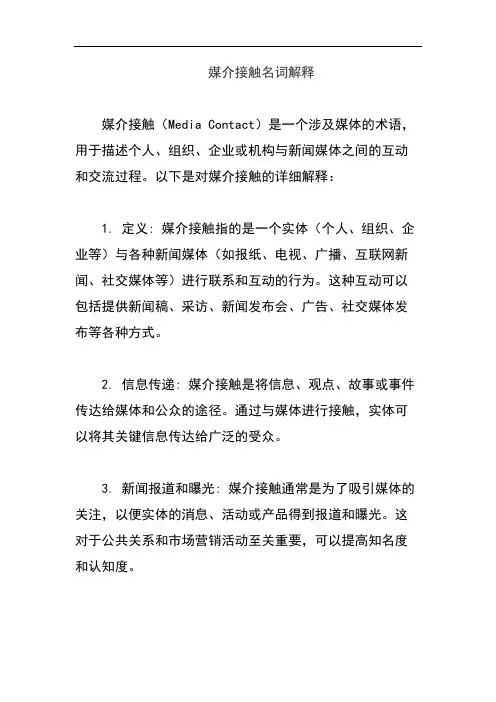
媒介接触名词解释
媒介接触(Media Contact)是一个涉及媒体的术语,用于描述个人、组织、企业或机构与新闻媒体之间的互动和交流过程。
以下是对媒介接触的详细解释:
1. 定义: 媒介接触指的是一个实体(个人、组织、企业等)与各种新闻媒体(如报纸、电视、广播、互联网新闻、社交媒体等)进行联系和互动的行为。
这种互动可以包括提供新闻稿、采访、新闻发布会、广告、社交媒体发布等各种方式。
2. 信息传递: 媒介接触是将信息、观点、故事或事件传达给媒体和公众的途径。
通过与媒体进行接触,实体可以将其关键信息传达给广泛的受众。
3. 新闻报道和曝光: 媒介接触通常是为了吸引媒体的关注,以便实体的消息、活动或产品得到报道和曝光。
这对于公共关系和市场营销活动至关重要,可以提高知名度和认知度。
4. 媒体关系管理: 媒介接触也包括与媒体建立和维护积极的关系。
这意味着与记者、编辑和新闻机构建立互信和合作,以便更容易获得媒体的关注和支持。
5. 危机管理: 媒介接触在危机管理中也起到关键作用。
在危机发生时,实体需要与媒体进行及时的沟通,以解释事件、提供信息并管理危机的影响。
总之,媒介接触是指与新闻媒体进行交流和互动的过程,用于传递信息、获得新闻报道、建立媒体关系和管理危机等。
这是公共关系、市场营销和危机管理等领域的重要活动。

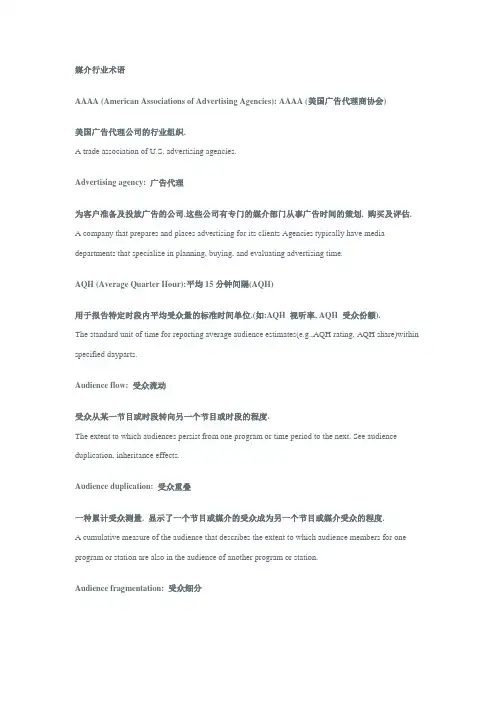
媒介行业术语AAAA (American Associations of Advertising Agencies): AAAA (美国广告代理商协会)美国广告代理公司的行业组织.A trade association of U.S. advertising agencies.Advertising agency: 广告代理为客户准备及投放广告的公司.这些公司有专门的媒介部门从事广告时间的策划, 购买及评估.A company that prepares and places advertising for its clients Agencies typically have media departments that specialize in planning, buying, and evaluating advertising time.AQH (Average Quarter Hour):平均15分钟间隔(AQH)用于报告特定时段内平均受众量的标准时间单位.(如:AQH 视听率, AQH 受众份额).The standard unit of time for reporting average audience estimates(e.g.,AQH rating, AQH share)within specified dayparts.Audience flow: 受众流动受众从某一节目或时段转向另一个节目或时段的程度.The extent to which audiences persist from one program or time period to the next. See audience duplication, inheritance effects.Audience duplication: 受众重叠一种累计受众测量. 显示了一个节目或媒介的受众成为另一个节目或媒介受众的程度.A cumulative measure of the audience that describes the extent to which audience members for one program or station are also in the audience of another program or station.Audience fragmentation: 受众细分是一种媒介的受众分散在该媒介的众多节目中的现象.如: 有线电视进一步细分了电视观众, 使个频道的观众份额减少.A phenomenon in which the audience for a medium is distributed across a large number of program services. Cable is said to fragment the television audience, resulting in a decreased average audience share for each channel.Audience polarization: 受众两极分化是一种与受众细分有关的现象.某媒介或频道的受众比起一般受众更多地收看/收听该媒介或频道.A phenomenon associated with audience fragmentation, in which the audiences for channels or stations use them more intensively than an average audience member.Audience turnover: 受众周转是一种受众行为.通常表示为某媒介累计受众与平均15分钟受众的比例.A phenomenon of audience behavior usually expressed as the ratio of a station's cumulative audience to its average quarter hour audience.Available audience: 可得受众在任一时间点确实有可能使用某媒介的总体人数.在实际工作中被定义为确实使用了某媒介的受众.The number of people who are, realistically, in a position to use a medium at any point in time. It is often operationally deaned as those actually using the medium (i.e., PUT or PUR levels).Average audience rating: 平均受众视听率在特定时期内,某媒介或节目平均时间点的视听率.例如: 测量仪数据报告的是在一个电视节目中平均每分钟的观众量.The rating of a station or program at an average point in time within some specified period of time. Metered data, for example, allow reports of audience size in an average minute during a television program.Cable penetration: 有线电视渗透在特定市场上家庭安装有线电视的程度.表示为安装有线电视的家庭所占的百分比.The extent to which households in a given market subscribe to cable service. Typically expressed as the percent of all TV households that subscribe to basic cable.Channel loyalty: 频道忠诚度累计受众行为的一种表现.一个节目的受众不成比例地成为同一频道另一节目的受众.A common phenomenon of aggregate audience behavior in which the audience for one program tends to be disproportionately represented in the audience for other programs on the same channel.Cume: 累计累计受众的简称.指在特定段时期内某媒介的全部非重叠受众. 当累计被表示为该市场人口的百分比时, 代表累计视听率.Short for cumulative audience, it is the size of the unduplicated audience for a station over a specified period. When the cume is expressed as percent of the market population it is referred to as cume rating.Cume duplication: 累计重叠在一段特定时期内,两个媒介共享受众的规模.The percentage of a station's cume audience that also listened to another station, within some specified period.Effective exposure: 有效暴露广告媒介策划中使用的概念.指受众必须有一定的广告暴露频率, 广告才能发生效用. 经常与有效频率交替使用.A concept in media planning stipulating that a certain amount of exposure to an advertising message is necessary before it is effective. Often used interchangeably with the term effective frequency.Fringe: 边缘时间在电视市场中,指傍晚时段(黄金段最初的时段)之前,和晚间新闻(黄金段最后的时段)之后的时段.In television, dayparts just before prime time (early fringe) and after the late news (late fringe).Gross impressions: 总暴露频次指在一段时期内暴露于某广告的受众总和. 因为有重叠受众,所以该数字有可能超过总体人口. The number of times an advertising schedule is seen over time. The number of gross impressions may exceed the size of the population since audience members may be duplicated.GRP (Gross Rating Point): 总视听率点以占人口的百分比来表示广告的总体效果.GRP常用于一个广告的总体受众或媒介影响力. The gross impressions of an advertising schedule expressed as a percentage of the population. GRPs are commonly used to describe the size or media weight of an advertising campaign. GRPs=Reach×Frequency.Hammocking: 吊床效应一种电视节目编排策略.将一个新的或较弱的节目安排在两个受欢迎的节目中间播出, 以期提高中间节目的收视率.A television programming strategy in which an unproven or weak show is scheduled between two popular programs in hopes that viewers will stay tuned, thereby enhancing the rating of the middle program.Inertia: 惰性形容受众行为.指除非看到很厌恶的节目, 观众一般不会更换频道.A description of audience behavior that implies viewers are unlikely to change channels unless Provoked by very unappealing programming.Inheritance effect: 沿袭效应电视观众收视行为中的一种常见现象.即一个节目的观众会大批地成为接下来一个节目的观众. 有时被称为“导入节目效应”.观众的节目沿袭效应可视为一种特殊的频道忠诚性.A common phenomenon of television audience behavior in which the audience for one program is disproportionately represented in the audience of the following program. Sometimes called lead-in effects, audience inheritance can be thought of as a special case of channel loyalty.Late fringe: 晚间边缘时段(黄金时段最末的时段)紧接在晚间地区新闻(晚23点)之后的电视节目时段.In television, a daypart just after the late local news(11pm EST).Lead-in: 导入节目同一频道内在某一节目之前的一个节目.前一个节目的观众规模和组成是后一个节目收视率的重要决定因素.The program that immediately precedes another on the same channel. The size and composition of a lead-in audience is an important determinant of a program's rating.LOP (least objectionable program): 可以接受的节目Paul Klein 提出的电视观众行为理论.它指出人们收看电视的原因与节目内容无关, 人们会选择收看可以接受的(不厌恶的) 节目.A popular theory of television audience behavior attributed to Paul Klein, that argues people primarily watch TV for reasons unrelated to content, and they choose the least objectionable programs.Narrowcasting: 窄播一种节目制作编排策略.指广播电视台(网) 只制作播放同一种类型的节目或只迎合某一类受众的喜好.A programming strategy in which a station or network schedules content of the same type or appealing to the same subset of the audience.Net weekly circulation: 每周净循环在一周中收听/收看某媒介的累计或非重叠受众.The cume or unduplicated audience using a station or network in a week.Preempt: 预先占有附属广播电视台采取的行动,即用自己编排的节目取代所属广播电视网的节目.广告商也可以以高价来预先购买特定的广告时间.An action, taken by an affiliate, in which programming fed by a network is replaced with programming scheduled by the station. Certain types of commercial time can also be preempted by advertisers willing to pay a premium for the spot.Prime time: 黄金时间指从19:00-23:00 的电视节目时段.鉴于FCC的规定, 广播电视网只可以在20:00-23:00的时段内向附属台加入节目.A television daypart from 7p.m. to 11p.m.EST. Due to FCCeregulations, broadcast networks typically feed programming only from 8p.m.to llp.m.EST.Rating:视听率简单的说就是市场总体人口中收听/收看某媒介或节目的个人或家庭所占的比例.In its simplest form, the percentage of persons or households tuned to a station, program, or daypart out of the total market population.Reach: 到达在某特定时期内,某媒介或广告的非重叠个人或家庭受众的总数. 有时表示为占总体人口的百分比.The number of unduplicated persons or households included in the audience of a station or a commercial campaign over some specified period. Sometimes expressed as a percentage of the market population.Repeat viewing: 重复收视一个连续节目的观众收看该节目其它部分的程度.The extent to which the audience for one program is represented in the audience of other episodes of the series.Spill: 溢出指本地区观众收看非本地电视台节目及外地观众收看本地节目的程度.The extent to which nonmarket stations are viewed by local audiences, or local stations are viewed by audiences outside the market.。
传媒中的名词解释随着现代科技的快速发展,传媒行业正变得日益重要。
我们每天都在使用各种传媒渠道,如电视、互联网和社交媒体。
然而,这个行业充斥着各种专业术语和名词,很多人并不了解它们的具体含义。
本文旨在解释一些传媒中常见的名词,并探讨它们在行业中的作用和意义。
一、媒体首先,媒体是一个广义的术语,它涵盖了所有传递信息的方式和工具。
媒体可以分为传统媒体和新兴媒体两类。
1. 传统媒体传统媒体主要指报纸、电视、广播等传统形式的媒介。
报纸是最早的传媒工具之一,通过印刷纸张将新闻和信息传递给读者。
电视和广播则通过电波传播声音和图像。
传统媒体在信息传递和新闻报道方面发挥着重要作用,但受限于纸张和电波的传播范围。
2. 新兴媒体新兴媒体是指互联网和移动设备等新兴技术所产生的媒体形式。
随着互联网的普及,人们可以通过网页、应用程序和社交媒体等渠道获得大量信息。
新兴媒体具有即时性、互动性和全球范围的特点,使我们能够与世界各地的人实时交流和分享信息。
二、传媒行业1. 新闻学新闻学是研究新闻传播的学科,涉及新闻报道、编辑和传播等方面。
新闻学的发展使人们对新闻报道的真实性、客观性和道德性有了更高的要求。
新闻学的研究不仅包括新闻的传播方式,还包括社会、经济和政治因素对新闻产生的影响。
2. 媒体研究媒体研究是一门围绕媒体、传媒和通信的学科。
它包括对媒体内容、媒体组织、媒体效果和媒体受众等方面的研究。
媒体研究分析了媒体在社会、文化和经济方面的影响,并通过各种研究方法和理论来深入探讨。
三、媒介效应媒介效应是指媒体对受众的影响和塑造。
媒介效应可以分为短期和长期效应。
1. 短期效应短期效应是指媒体在时间有限条件下对受众的直接影响。
例如,广告可以通过媒体渠道传达商品信息,激发消费者购买欲望。
短期效应还可以包括新闻报道对公众情绪和观点的影响。
2. 长期效应长期效应是指媒体对受众长期观念和行为的塑造。
例如,电视、电影和网络游戏等媒体形象对年轻人的行为模式和价值观念产生深远的影响。
广告业常用术语1. 广告主(Advertiser):广告主是指购买广告空间或时间,以宣传其产品、服务或品牌的企业或个人。
2. 广告代理(Advertising Agency):广告代理是指为广告主提供广告策划、创意、制作和发布等服务的专业机构。
3. 广告预算(Advertising Budget):广告预算是指广告主在广告活动上投入的财务资源,包括广告制作、发布和推广等费用。
4. 广告目标(Advertising Objective):广告目标是指广告主希望通过广告活动实现的具体目标,如提高品牌知名度、促进产品销售或改变消费者行为等。
5. 广告创意(Advertising Creativity):广告创意是指广告制作过程中所运用的创意思维和艺术表现手法,以吸引目标受众的注意力并传达广告信息。
6. 广告媒介(Advertising Media):广告媒介是指广告信息传播的渠道和平台,如电视、广播、报纸、杂志、互联网等。
7. 广告受众(Advertising Audience):广告受众是指广告信息的目标接收者,即广告主希望影响和吸引的潜在消费者。
8. 广告效果(Advertising Effectiveness):广告效果是指广告活动对目标受众产生的影响和结果,如提高品牌知名度、增加产品销量或改善消费者态度等。
9. 广告投放(Advertising Placement):广告投放是指将广告信息发布在特定的广告媒介上,以实现广告目标的过程。
10. 广告监测(Advertising Monitoring):广告监测是指对广告活动的效果进行实时跟踪和评估,以了解广告投放的效果和受众反应,从而优化广告策略。
1. 目标市场(Target Market):这是广告主希望其广告信息能够到达并产生影响的特定群体。
了解目标市场有助于定制更有效的广告策略。
2. 品牌形象(Brand Image):品牌形象是指消费者对某一品牌的整体印象和感知,包括品牌个性、价值观和定位。
Practical English: 大众媒介广告术语ABCA:above-the-line advertising 线上广告广告代理商能从媒介获得佣金(代理费)的广告,如报刊广告、广播广告、电视广告、影院广告、户外广告等。
account executive (AE) 客户经理广告公司的业务人员职称。
客户经理往往须负责下列工作:1,与客户及内部其他部门共同计划广告(planning),向各部门传达客户的诉求;2,内部协调(coordination);3,将广告设计稿提供给客户;4,监督执行政府的有关广告规章和法规(regulatory matters);5,利润管理(agency profit management)。
客户经理通过计划和协调公司的服务部门,为客户提供更好的服务。
account service 客户服务客户服务是广告代理商的中心工作,肩负着使客户满意从而建立起长期的合作关系,及推动广告代理商内部工作有效运转的任务。
它是广告代理商直接同客户进行沟通、交流的一种功能。
advertising agency 广告代理商习惯上称为“广告公司”,即《中华人民共和国广告法》中所称的广告经营者,一般设有许多职能和业务部门。
advertising campaign 广告活动有时称为“运动”或“战役”。
广告活动包括以下四个重点:制作适当的销售信息、及时传达给受众、选择适当的时机,用合理的成本。
广告主制定一项能测定的目标后,为达到这一目标制定广告战略,然后在市场上执行,包括:广告计划、广告制作、销售及营销等。
advertising department 广告部分为企业的广告部和媒介的广告部。
企业的广告经理负责拟定、审核及实施企业的广告计划。
一般也是负责有关广告的具体工作。
媒介的广告部经理负责出售报刊等的版面,广播、电视的时间等。
airport advertising 机场广告利用机场的候机室及在机场内其他各种场地和设备上制作刊出的广告,也包括在指示牌上制作的广告。
媒介术语Infosys TV 术语Infosys TV术语是Infosys TV 软件提供的一系列在广播、电视受众视、听率分析过程中常用的媒介指标,如收视(听)率、到达率%、市场份额%、观众构成%、毛评点、每毛评点成本、千人成本、平均暴露频次等。
这些指标基于收视(听)率调查数据运算获得,按照其在媒介研究过程中的不同作用,可以分成节目收视状况分析指标、受众收视习惯分析指标、广告投放计划排期指标和广告效果评估指标四大类,是电视台节目编排、调整、评估和广告主(广告公司)媒介投放计划制定和效果评估的重要参考依据。
AcCont(000) 累积接触度(以千人为单位)Accumulated Contacts in 000's指多个载体所到达的总人次,以千人次表示,也即多个载体的接触度之和。
The accumulated number of individuals reached by a plan of supports expressed in thousands.公式: AcCont(000) = 计划中每个载体的接触度( 以千人为单位) 之和Formula: AcCont(000) = Sum of C ont(000) for each supports in a planAcCost 累积成本Accumulated Cost计划中各载体广告段位的累积价格。
The total rate card cost for a plan of supports.公式: AcCost = 计划中每个载体的成本之和Formula: AcCost = Sum of the c ost for each support in the planAcCost/GRP 累积每收视点成本( 也称累积每毛评点成本)Accumulated Cost per rating point (also known as AcCost per GRP)每个载体的广告成本除以累积毛评点数。
The sum of the costs of each support divided by the number of Accumulated GRPs.公式: AcCost/GRP = 累积成本/ 累积毛评点Formula: AcCost/GRP =AcCost/ AcGRPAcCost/Cont 累积每千人成本( 以千人为单位)Accumulated Cost per thousand (also known as AcCost per thousand)计划中各载体分别到达一千人次所需的累积成本,以元表示。
The accumulated cost of the plan of supports for every one thousand accumulated contacts, expressed in currency units.公式:AcCost/Cont = 累积成本x 1000 / 累积接触度(000)Formula: AcCost/Cont = AcCost x 1000 / AcCont (000)AcDuration 累积时长Accumulated Duration计划中各载体的累积持续时间或长度,以秒表示。
The accumulated duration or length of a plan of supports, expressed in seconds公式: AcDuration = 计划中每个载体的时长之和Formula: AcDuration =Sum of the durations of each supports in a plan.AcGRP 累积收视率(以百分比为单位) ( 也称累积毛评点)Accumulated Ratings in % (also known as Accumulated Gross Rating Point)累积接触度( 以千人为单位) 除以推及人口,以百分比表示。
The relation between the number of Accumulated Contacts in thousands divided by the Universe, expressed in percentage.公式: AcGRP = 累积接触度(000)/ 总体推及人口Formula: AcGRP = AcCont(000)/UniverseCov(000) 覆盖率(以千人为单位)Accumulated Reach in 000's for a Series of Supports指特定的媒介计划(广告投放计划)实施时所能达到的不重复的观众人数,以千人表示。
The total number of individuals, expressed in thousands, who have viewed at least once within a campaign or a plan of supports.Formula: Cov(000) = Sum of the co ntacts in 000's for supportsCov% 覆盖率(以百分比为单位)Accumulated Reach in % for a Series of Supports指特定的媒介计划(广告投放计划)实施时所能达到的不重复的观众人数占总体电视推及人口的百分比。
The total number of individuals who have viewed at least once within a campaign or a plan of supports, expressed as a percentage.Formula: Cov% = Sum of the co ntacts in 000's for supports / Universe of the chosen target TgAfin% 集中度Affinity (also known as Conversion)目标观众(如15到34岁的人群)的收视率(%)与参照观众(如所有4岁以上的人口)的收视率(%)之间的关系指数。
注意:用户可选择参照观众。
An index of the relationship between the rating in % for a target audience (i.e. All 15-34) and for a reference audience (i.e. All Individuals 4+). Note: The user can choose the reference audience. 公式: TgAfin% = {目标观众收视率(%) / 参照观众收视率(%)} x 100Formula: TgAfin% = (Rtg% for the target audience / Rtg% for the reference audience) x 100 AvFid 平均忠实度Average Fidelity反映观众平均忠诚度的指数,以百分比表示,最小值与最大值分别是0%和100%。
注意:指数越高,观众对特定时段越忠实。
An index showing the average loyalty of viewers, expressed as a percentage with a minimum and maximum result of 0% and 100% respectively. Note: The higher the index, the viewers are more loyal for the specified period and conditions on an average daily basis.公式:AvFid = ( 收视率% / 平均到达率%) x 100Formula: AvFid = (Rtg% / AvRch%) x 100AvRch% 平均到达率( 以百分比为单位)Average Reach in %特定时段内平均每天的符合到达条件的接触总人数占总体电视推及人口的比例。
到达条件一般是“至少收看了1分钟”。
注意:用户可以改变收看的最小分钟数或收看时间在整个时段中的最小百分比来自行定义到达条件。
The percentage of the average daily contacts divided by the universe of the respected target. By default, the definition of "contacts" is "having viewed at least 1 minute" for the conditions specified.Note: The definition can be defined by the user either by the number of minute(s) viewed or percentage of the time band viewed.Formula: AvRch% = (Sum of the c ontacts in 000's per day / Number of days) / Universe of the respected target x 100AvRch(000) 平均到达率(以千人为单位)Average Reach in 000's在特定时段内平均每天的符合到达条件的接触总人数,以千人表示。
“接触度”的默认定义为在指定条件下“至少收看了1分钟”。
注意:用户可根据收看的最小分钟数或收看时间在整个时段中的最小百分比来自行定义。
The average daily contacts expressed in thousands. By default, the definition of "contacts" is "having viewed at least 1 minute" for the conditions specified. Note: The definition can be defined by the user either by the number of minute(s) viewed or percentage of the time band viewed.Formula: AvRch(000) = Sum of c ontacts in 000's per day / Number of daysCont(000) 接触度(以千人为单位)Contacts in 000's特定载体所到达的人次,以千人次表示。